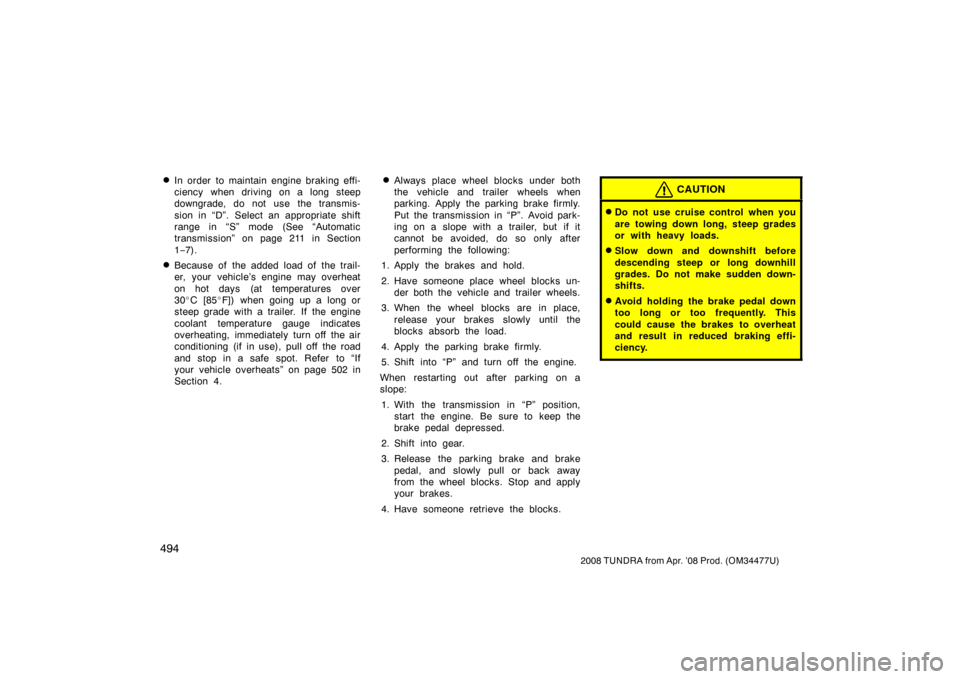Page 274 of 621

264
2008 TUNDRA from Apr. ’08 Prod. (OM 34477U)
�When vehicle speed falls below 40
km/h (25 mph)
�When vehicle stability control is acti-
vated
When vehicle speed drops 16 km/h (10
mph) below the set speed, the cruise con-
trol is cancelled and the set speed is
erased from memory.
The “CRUISE” indicator light remains on
to indicate that the system is still in op-
eration.
To turn the cruise control off, press the
“ON −OFF” button. Make sure the
“CRUISE” indicator light is off.
If the cruise control automatically cancels
out other than for the above cases, have
your vehicle checked by your Toyota deal-
er at the earliest opportunity.
RESUMING THE CRUISE CONTROL
If the cruise control is temporarily can-
celled, the cruising speed can be resumed
by pushing the lever up in the “+ RES”
direction.
Vehicle speed must be above 40 km/h (25
mph). RESETTING TO A FASTER SPEED
Push the lever up in the “+RES” direction
and hold it. Release the lever when the
desired speed is attained. While the lever
is held up, the vehicle will gradually gain
speed.
However, a faster way to reset is to ac-
celerate the vehicle and then push the
lever down in the “−
SET” direction.
RESETTING TO A SLOWER SPEED
Push the lever down in the “ −SET” direc-
tion and hold it. Release the lever when
the desired speed is attained. While the
lever is held down, the vehicle speed will
gradually decrease.
However, a faster way to reset is to de-
press the brake pedal and then push the
lever down in the “− SET” direction.
Even if you downshift from “D” to “S” with
the cruise control on, engine braking will
not be enabled because the cruise control
is not cancelled. To decrease the vehicle
speed, reset to a slower speed with the
cruise control lever or depress the brake
pedal. If you use the brake pedal, cruise
control is cancelled. CRUISE CONTROL FAILURE WARNING
If the “CRUISE” indicator light flashes
when using the cruise control, press the
“ON
−OFF” button to turn the system off
and then press it again to turn it on.
If any of the following conditions then oc-
curs, there is some trouble in the cruise
control system.
�The indicator light does not come on.
�The indicator light flashes again.
�The indicator light goes out after it
comes on.
If this is the case, contact your Toyota
dealer and have your vehicle inspected.
Page 504 of 621

494
2008 TUNDRA from Apr. ’08 Prod. (OM 34477U)
�In order to maintain engine braking effi-
ciency when driving on a long steep
downgrade, do not use the transmis-
sion in “D”. Select an appropriate shift
range in “S” mode (See “Automatic
transmission” on page 211 in Section
1−7).
�Because of the added load of the trail-
er, your vehicle’s engine may overheat
on hot days (at temperatures over
30 �C [85 �F]) when going up a long or
steep grade with a trailer. If the engine
coolant temperature gauge indicates
overheating, immediately turn off the air
conditioning (if in use), pull off the road
and stop in a safe spot. Refer to “If
your vehicle overheats” on page 502 in
Section 4.
�Always place wheel blocks under both
the vehicle and trailer wheels when
parking. Apply the parking brake firmly.
Put the transmission in “P”. Avoid park-
ing on a slope with a trailer, but if it
cannot be avoided, do so only after
performing the following:
1. Apply the brakes and hold.
2. Have someone place wheel blocks un- der both the vehicle and trailer wheels.
3. When the wheel blocks are in place, release your brakes slowly until the
blocks absorb the load.
4. Apply the parking brake firmly.
5. Shift into “P” and turn off the engine.
When restarting out after parking on a
slope: 1. With the transmission in “P” position, start the engine. Be sure to keep the
brake pedal depressed.
2. Shift into gear.
3. Release the parking brake and brake pedal, and slowly pull or back away
from the wheel blo cks. Stop and apply
your brakes.
4. Have someone retrieve the blo cks.CAUTION
�Do not use cruise control when you
are towing down long, steep grades
or with heavy loads.
�Slow down and downshift before
descending steep or long downhill
grades. Do not make sudden down-
shifts.
�Avoid holding the brake pedal down
too long or too frequently. This
could cause the brakes to overheat
and result in reduced braking effi-
ciency.
Page 606 of 621

596
2008 TUNDRA from Apr. ’08 Prod. (OM 34477U)
XS73028
Instrument panel
14. ALT�S 5 A: Charging system
15. TURN�HAZ 15 A: Turn signal lights,
emergency flashers, towing converter
16. F/PMP 15 A: No circuit
17. ETCS 10 A: Multiport fuel injection
system/S equential multiport fuel injec-
tion system, electric throttle control
system
18. MET�B 5 A: Gauges and meters
19. AMP 30 A: Audio system, rear view
monitor, navigation system, rear seat
entertainment system 20. RAD NO.1 15 A:
Audio system, rear
view monitor, navigation system, rear
seat entertainment system
21. ECU�B1 7.5 A: Multiplex communica-
tion system, Multiport fuel injection sys-
tem/sequential multiport fuel injection
system, auto anti− glare inside rear
view mirror, power outlets, power front
drivers seat, power tilt and telescopic
system
22. DOME 7.5 A: Interior lights, personal
lights, vanity lights, engine switch light,
foot light, door courtesy lights, acces-
sory meter
23. HEAD LH 15 A: Left−hand headlight
(high beam)
24. HEAD LL 15 A: Left−hand headlight
(low beam)
25. INJ 10 A: Multiport fuel injection sys-
tem/sequential multiport fuel injection
system, ignition system
26. MET 7.5 A: Gauges and meters
27. IGN 10 A: SRS airbag system, multi-
port fuel injection system/sequential
multiport fuel injection system, engine
immobilizer system, cruise control sys-
tem
28. HEAD RH 15 A: Right−hand headlight
(high beam) 29. HEAD RL 15 A:
Right−hand headlight
(low beam)
30. EFI NO.2 10 A: Multiport fuel injection
system/s equential multiport fuel injec-
tion system, leak detection pump
31. DEF I/UP 5 A: No circuit
32. SPARE 5 A: Spare fuse
33. SPARE 15 A: Spare fuse
34. SPARE 30 A: Spare fuse
35. INVERTER 15 A: Power outlet No cir-
cuit(115 V)
36. FR P/SEAT LH 30 A: Power front driv-
ers seat
37. DR/LCK 25 A: Multiplex communication
system
38. OBD 7.5 A: On−board diagnosis sys-
tem
39. PWR OUTLET 15 A: Power outlets
40. CARGO LP 7.5 A: Cargo lamp
41. AM1 7.5 A: Shift lock system, starting
system
42. A/C 7.5 A: Air conditioning system
4
3. MIR 15 A: Outside rear view mirror
control, outside rear view mirror heat-
ers
44. FR P/SEAT RH 30 A: Power front pas-
senger seat
Page:
< prev 1-8 9-16 17-24